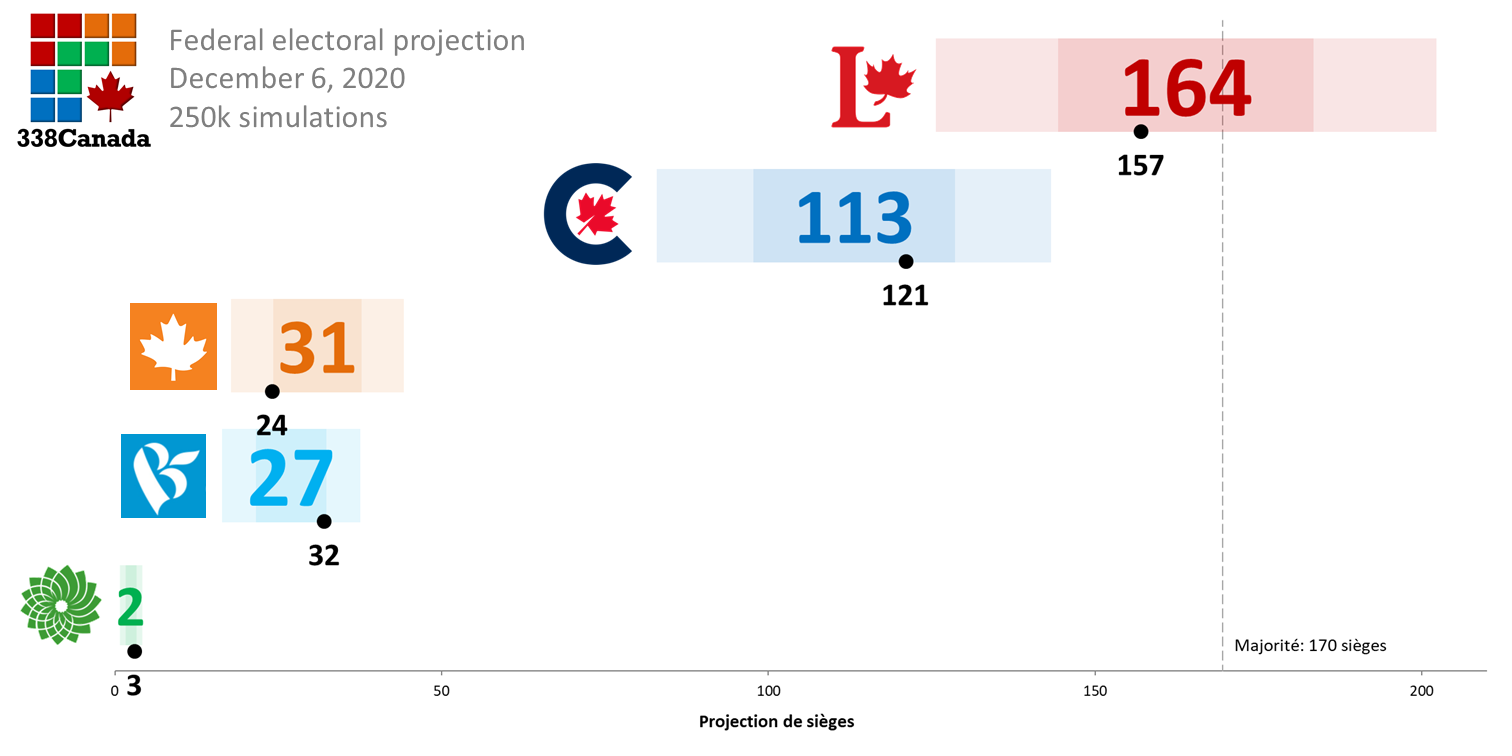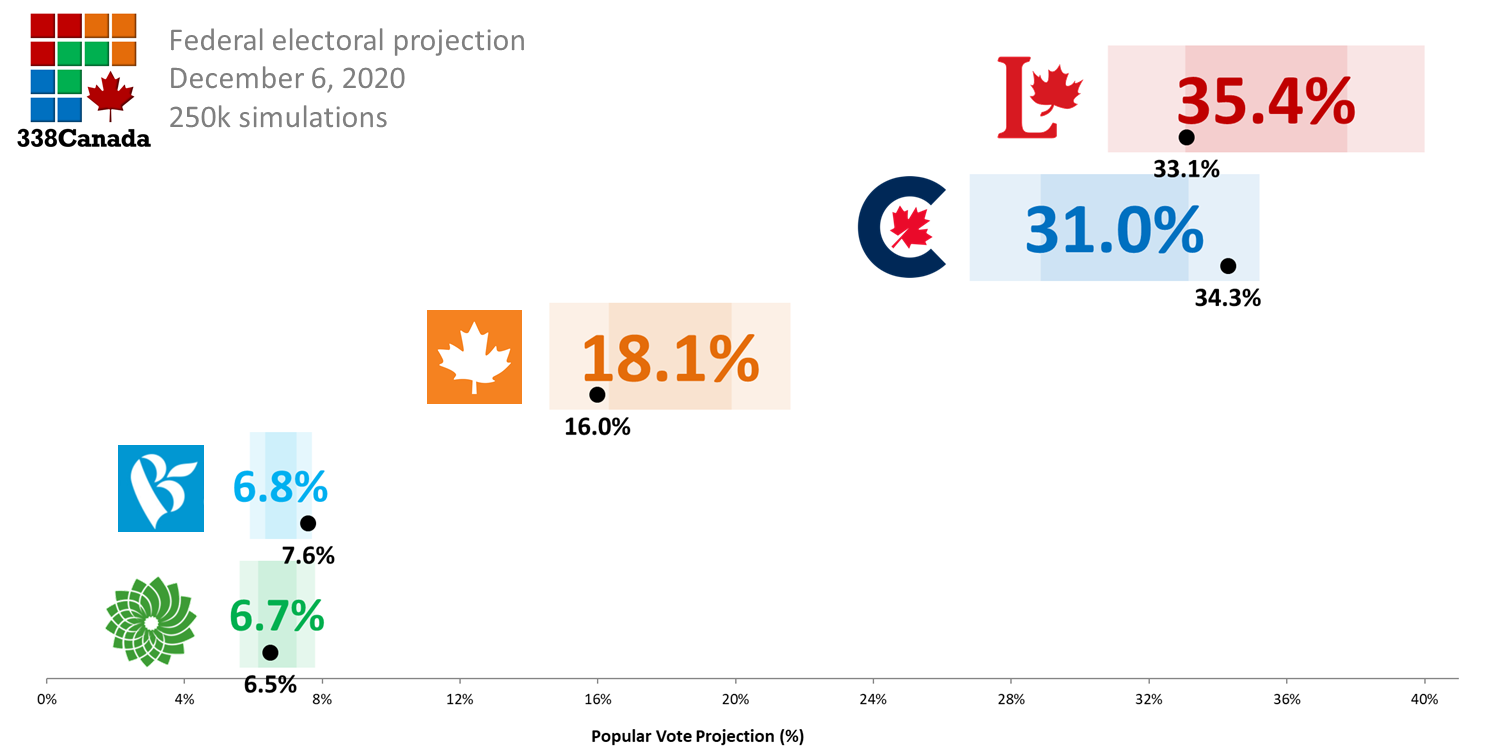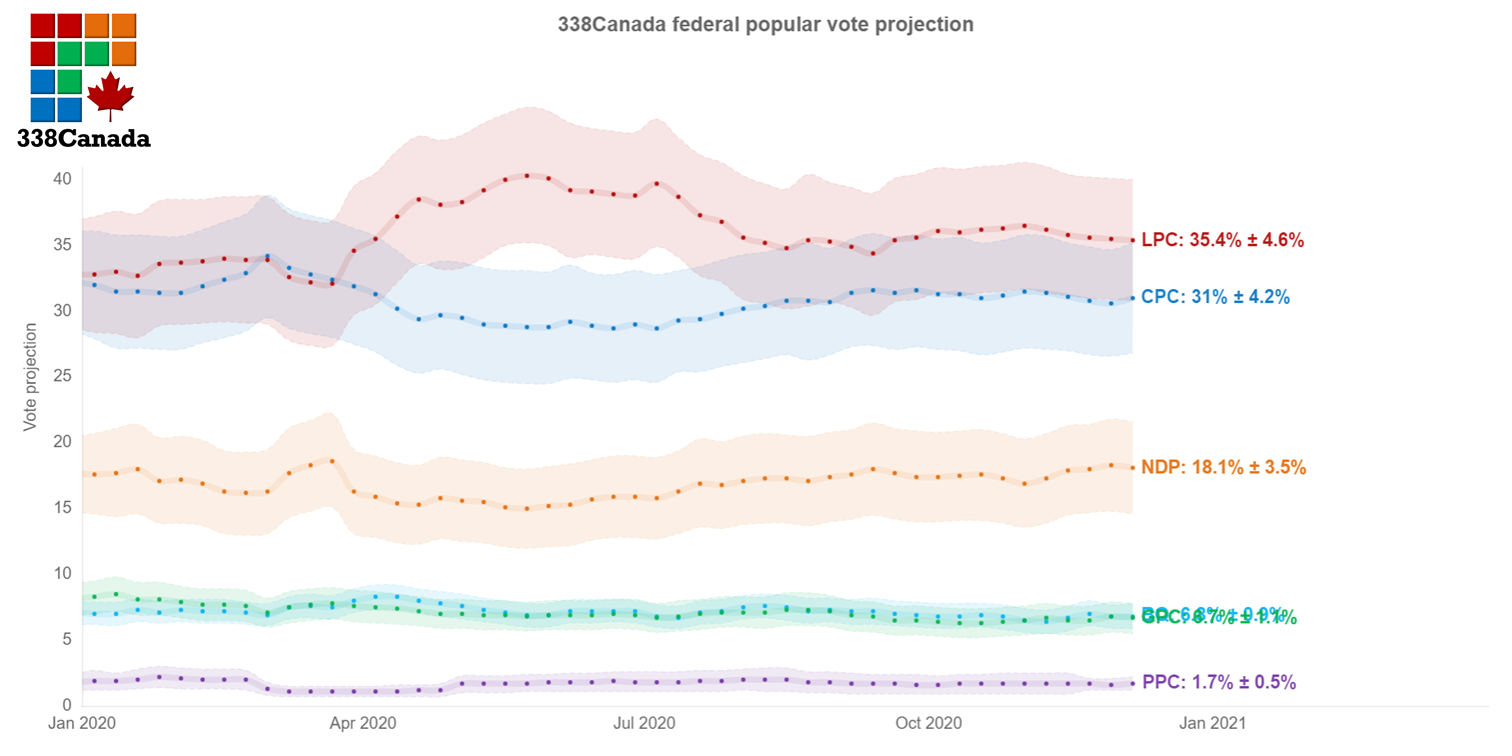338Canada: The federal Liberals hold steady. Jason Kenney sinks.
Philippe J. Fournier: While Canadians still mostly approve of their political leaders, a spring federal election may hinge on a smooth vaccine rollout

Trudeau meets with Kenney on Parliament Hill on Dec. 10, 2019 (CP/Sean Kilpatrick)
Share
Although many Canadians will be restricted to visit loved ones during the upcoming Christmas/Holiday break, reports from the scientific community indicate the end of the pandemic might come sooner rather than later. In a recent column in Nature, science writer Asher Mullard stated that “Counting up all vaccine deals per capita, Canada leads the pack, with nearly nine doses per person”, and added a quote from Dr. Andrea Taylor of Duke University’s Global Health Institute: “Canada has done exactly what we would expect a high-income country to do, and they’ve done the right thing by their country.”
While there remains uncertainty on the timing of this mass vaccination program and how it will unfold in Canada throughout 2021, such news should help many Canadians feel some cautious optimism for 2021.
As for Canadians’ impressions of their governments’ handling of the COVID-19 pandemic, several polls published in the past weeks indicates there is still general strong support for Canada’s elected officials, with a few notable regional exceptions.
- In its latest weekly report, Léger measures satisfaction towards the federal government at 65 per cent nationally, including 68 and 67 per cent in Quebec and Ontario, respectively. However, it was the Alberta numbers that gave us pause: 46 per cent of Albertans approve of the federal government’s handling of the pandemic, while only 30 per cent of Alberta respondents approve of their own provincial government. While the poll’s Alberta sample was modest and thus had higher uncertainty, Jason Kenney and the UCP losing support has become a trend over the past weeks and was detected by other pollsters as well. Nationally, 60 per cent of Canadians approve of their provincial government’s handling of the pandemic, down 20 points since July according to Léger.
- The Angus Reid Institute also released its latest approval numbers last week and they showed mostly similar trends. On the federal front, ARI measures that a majority of Canadians (56 per cent) still approve of the federal government, although that figure has dropped 10 points since late summer. Provincially, ARI also sees trouble on the horizon for Jason Kenny: only 40 per cent approval from Albertans, the second lowest among the nine provinces included in the report.
- Finally, Ipsos also has 60 per cent of Canadians approving of Justin Trudeau’s handling of the pandemic, a stable level since October. As for premier approvals, Ipsos’s numbers confirm the current trends: John Horgan in British Colombia (78 per cent), François Legault in Quebec (75 per cent) and Doug Ford in Ontario (69 per cent) all receive mostly positive grades from their constituents, while Jason Kenney in Alberta lags far behind with only 37 per cent.
We add these polls and many others to the 338Canada federal model and present today this projection update. As usual, all federal polls may be found on this page. For details on methodology, visit this page.
Nationally, the Liberals get an average support of 35 per cent and maintain a modest, but stable lead over the Conservatives, which stand at 31 per cent. The NDP currently sits at 18 per cent, marginally higher than its October 2019 election result:
[On the graph above, the coloured bars represent the projection’s 95 per cent confidence intervals and the black dots, the 2019 federal election results.]
Notice on the graph above, however, that each party’s 2019 result is well within the projection confidence intervals. Aside from the Liberals’ spring and summer pandemic bump, federal numbers have barely moved all year:
As is often the case, the regional numbers give a better picture of where the main parties stand:
- In Atlantic Canada, the Liberals enjoy a massive average lead of 20 points over the Conservatives and would, according to these numbers, probably suffer no loss of seats in the region (the LPC won 26 of 32 seats in Atlantic Canada in 2019).
- In Quebec, polls do measure a tight race for first place between the Liberals and the Bloc Québécois, with an edge going to the LPC. However, since Liberal support in Quebec is more concentrated in urban Montreal and Quebec City, the Bloc could still compete to win the most seats in the province. The Conservatives are stuck at 16 per cent in the province, a level matching their 2019 results in Quebec.
- In Ontario, the Liberals lead with an average of 40 per cent to the Conservatives’ 33 per cent. The Liberals are projected leading in over 70 of the province’s 121 federal seats (they won 79 Ontario seats in 2019).
- In Manitoba, Saskatchewan and Alberta, the Conservatives are projected leading in virtually all regions except in and around Winnipeg.
- Finally, British Columbia continues to be a mystery for federal pollsters. In the past week alone, we have seen polls showing the Liberals ahead by double digits (Léger), all three main parties in a virtual tie (Angus Reid), and the NPD in the outright lead (Nanos Research, paywalled). The current 338Canada average has the Liberals ahead by four points in the province over the NDP—a gap much smaller than the projection’s confidence intervals.
Seat-wise, the Liberals remain in front with an average of 164 seats, just under the 170-seat threshold for a majority in the House of Commons. The Conservatives stand at 113 seats on average:

The NDP’s projection currently sits at 31 seats, the Bloc Québécois 27 seats and the Greens, 2 seats. Again, these projections closely align with last year’s federal election results.
Assuredly, the focus of early 2021 will centre on how, and how soon, Canadians will be administered the COVID-19 vaccines. Ottawa may have already purchased more than its share of vaccines, but the logistics of this mass vaccination—and to what extent provincial and federal authorities will coordinate their operations—will be a test for many elected officials in this country.
If vaccinations do begin early in 2021 (we should assume that health workers and senior citizens will be first in line), and the rollout goes mostly smoothly throughout winter and into the spring, the Liberals could be tempted to try to take advantage of this unique situation and trigger a spring election to regain a majority—perhaps even before the ominously historic budget is tabled by Finance Minister Chrystia Freeland.
On the other end, should there be massive delays in the rollout and increasing bickering between provinces and the federal government, it could be the opposition parties that smell Liberal blood in the waters. Nevertheless, while the Conservatives would probably get most Bloc MPs on board for a snap election, it would once again fall on Jagmeet Singh’s party to rescue the Liberals on a confidence motion—unless Justin Trudeau decides to push all his chips in the pot for one last kick at the can?
And therefore how efficient the vaccine rollout goes could very well decide the fate of this 43rd federal parliament. We here at 338 HQ will continue to track all the numbers to try to accurately paint the political landscape in Canada. Even though the second wave is hitting the country much harder than did the first, there should be optimism in the air for 2021. It will not be boring for sure. Stay safe out there, dear readers.
Follow 338Canada on Twitter.

